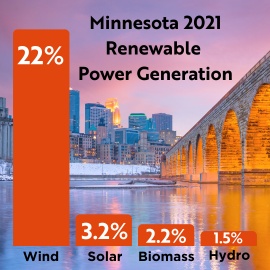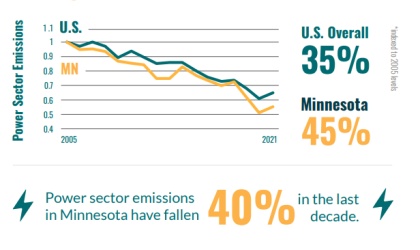Minnesota Helps Lead The Transition to Cleaner, Cheaper, More Sustainable Energy
 | Delainey Thorud, Manager, Membership and Operations |

 | Delainey Thorud, Manager, Membership and Operations |
In 2021, Minnesota was one of the leading states in its transformation to cleaner, cheaper, more sustainable energy. The 2022 Minnesota Energy factsheet was released by Clean Energy Economy Minnesota (CEEM) in conjunction with the Business Council for Sustainable Energy as part of the 2022 Sustainable Energy in America Factbook. The Minnesota Energy Factsheet highlights trends that are influencing national and state investments, and energy supply and demand. The factsheet showed that renewable energy was the largest source of electricity generation in Minnesota.

Among the other findings, the factsheet revealed that 28% of Minnesota's electricity is provided through wind, solar, hydro, and biomass energy generation. In the past five years, Minnesota has added 1.1 gigawatts (GW) of solar and 1.2 GW of wind. As of 2021, Minnesota has 6.5 GW of total installed renewable capacity. Wind power was the largest source of renewable energy, providing 22% of all power generated. The remaining renewable power generation came from solar power at 3.2%, biomass/waste-to-energy power at 2.2%, and hydro power at 1.5%.
Renewable energy generation accounted for 81% of all new capacity in Minnesota in the last decade. No new coal-fired power plants have been built in the state during this time, and Minnesota has retired over 950 megawatts (MW) of coal-fired power plants and plans to have all coal plants retired by 2035. The retirement of these coal plants has enabled the state to fill the gap with more renewable energy. Minnesota saw over 400MW of wind and solar generation added in 2021.
Minnesota is finding success in advancing renewable energy generation and is also using energy more efficiently. In the past decade, Minnesota has advanced its energy productivity, or how efficiently energy is used, by 29%. This includes a 4% increase between 2020 and 2021. According to the American Council for Energy-Efficient Economy, Minnesota is ranked first in the Midwest and 9th in the county for overall energy efficiency programs.
Minnesota's energy leadership grows
Minnesota is leading the Midwest and the country in energy efficiency and has no plans to slow down. In 2021, Governor Tim Walz signed the Energy Conservation and Optimization Act (ECO Act) into law. One of the goals of the ECO Act is to modernize the previous Conservation Improvement Program (CIP) by taking a more holistic approach to energy efficiency programming. The ECO Act also focused on the state's overall economy-wide energy savings goal by raising it from 1.5% to 2.5%. According to the Minnesota Department of Commerce, the electric utilities in the state have met or exceeded the previous goal of 1.5% annual energy savings each year since 2019. Natural gas utilities have also met or exceeded their 1% annual energy savings goals. Data has yet to be released related to annual energy savings in 2020 and 2021.

In 2021, 52% of Minnesota's power came from zero-carbon generation sources such as renewables and nuclear power, while the national average is only 39%. Minnesota's largest power generator, Xcel Energy's 2020-2034 Integrated Resource Plan (IRP) calls for an 86% reduction in carbon emissions from 2005, and for 81% of Xcel's electricity to be generated by carbon-free resources by 2032. The IRP was approved by the Minnesota Public Utilities Commission (PUC) on February 8, 2022 after three long years of modeling, advocacy work and negotiations. The IRP also includes plans for two new generation tie lines, bringing added capability to interconnect and deliver renewables. "The new transmission lines and other measures in the IRP will provide immense opportunities for renewable energy development in the heavily constrained MISO West," said Peder Mewis, Regional Policy Manager – West at CGA.
Subscribe to our newsletter for the latest on energy & our work

Minnesota is also on its way to achieving energy independence with energy imports falling to 10% in 2021, compared to 22% in 2012. The decline of energy imports comes even as electricity consumption increased by 3 percent from 2020-2021. The decline has also coincided with falling emission levels. Since 2011, Minnesota power sector emissions have fallen 40% and are 45% below 2005 levels. The nationwide average for emission reductions is only 35%. These emission reductions are largely due to the fact that since 2011, 81% of all new electricity generation capacity added has been renewable energy.
Regarding the 2022 Minnesota Energy Factsheet, the Executive Director of CEEM, Gregg Mast, said, "The data from last year shows how the clean energy transition is happening in Minnesota in real time, and the decline of energy imports is an especially exciting metric as we work to achieve energy independence. The challenges of 2021 have demonstrated why it's more important than ever to continue expanding our clean energy sector with thoughtful policy and smart investments."
"The success we've seen in advancing renewable energy in Minnesota – and throughout the Midwest – is the result of the hard work of multiple stakeholders working behind the scenes to build partnerships and tackle the tough issues," said Peder Mewis. "There is no doubt that the growth of renewables in Minnesota is contributing to the state in multiple ways. Renewable energy is great for business, the environment, and Minnesota's economy."